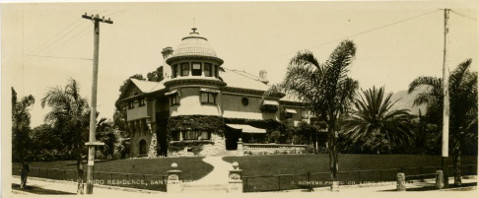Prynce Hopkins
Distinctive Home at Garden and Pedregosa

This house at 1900 Garden Street was home for many years to Prynce Hopkins. His father, Charles, had the house built in 1897 as a summer home for the family. Charles was from San Francisco and was a major stockholder in the Singer Sewing Machine Company. Francis Wilson, architect of the city’s train depot, originally designed the house. Mrs. Hopkins had the house redone in the popular Spanish-Colonial style in 1931.
Prynce Hopkins was born in 1885. While attending Ojai’s Thacher School, he demonstrated his fascination for the new flying machines by designing a working model for a helicopter. He earned degrees from London University, Yale, and Columbia and spoke five languages. Hopkins loved to travel, and he became deeply interested in Asia and eastern philosophies. In 1913, he returned to Santa Barbara to open a boy’s school.
Purchasing 13 acres on Mission Ridge, he built a large Swiss chalet, surrounded by vegetable gardens and a working miniature railway with a 200-pound locomotive. Hopkins was one of the earliest practitioners of the Montessori method of education. He felt play was just as important in the learning process as classroom work. Students attended class from 6 to 11 a.m. and spent the rest of the day in various pursuits, usually outdoors. As enrollment grew, Hopkins began to look for a new site to allow for expansion.
In 1915, Hopkins bought 32 acres above Oak Park, where the Samarkand complex is now, and built his new school. Many of the buildings were done in a Persian architectural style. Riding stables, a fully equipped gym, formal gardens — all were built with the idea of the importance of outdoor activities in mind. The outstanding feature of the grounds was the 1.5-acre artificial lake with a topographic map of the world. The continents had volcanoes that belched smoke and running rivers. Students could climb into a raft or rowboat and sail across the Pacific to San Francisco Bay or sail from New York to the Mediterranean in shipping lanes mapped out with wire. The boys, in effect, took part in a living geography lesson.
Opening in 1917, the innovative school was short-lived. Hopkins was a confirmed pacifist, an unpopular view especially when the U.S. entered in World War I. In April 1918, Hopkins was jailed and fined $20,000 under the Espionage Act for written works that purportedly gave aid to the enemy. One of his books, titled More Prussian Than Prussia, decried the U.S. penchant to enter the war and criticized what he perceived to be an erosion of civil liberty in this country.
Hopkins’s stance spelled the end of Boyland. In 1918, the grounds were used as an emergency hospital during the deadly influenza epidemic. Prynce’s mother shortly thereafter transformed the school into the Samarkand Hotel, thus giving the surrounding neighborhood its name.
Hopkins spent a number of years teaching in Europe and traveling, but he eventually returned to Santa Barbara. He lived in the family home until 1956, when he built a house in the International style at 1920 Garden Street. A founding member of the American Civil Liberties Union and the local United Nations chapter, Hopkins remained active until his death in 1970, celebrating his 85th birthday that year with a trip around the world.
Michael Redmon, director of research at the Santa Barbara Historical Museum, will answer your questions about Santa Barbara’s history. Write him c/o The Santa Barbara Independent, 122 West Figueroa Street, Santa Barbara, CA 93101.



